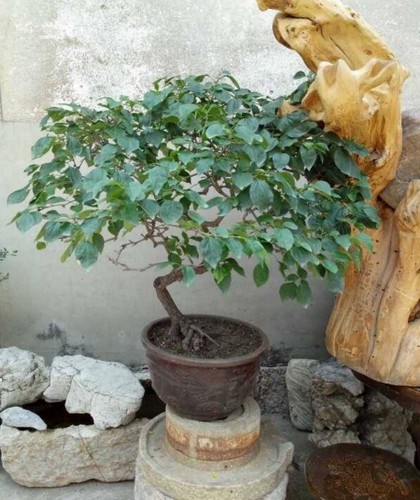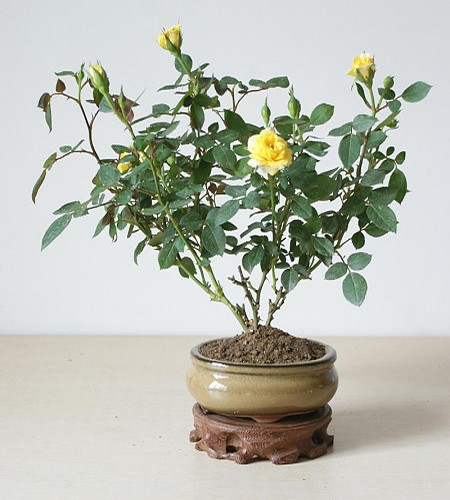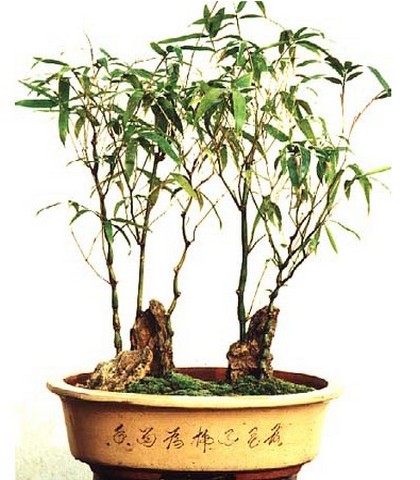The method of making lilac bonsai
A shrub or small tree of the genus Syringa, up to 5 m tall; bark grayish brown or gray. Branchlets, inflorescence rachis, pedicels, bracts, calyx, both sides of young leaves and petiole are glabrous and densely covered with glandular hairs. Branchlets thicker, sparsely lenticellate. Leaf blade leathery or thickly papery, ovoid to reniform, panicles erect, drawn from lateral buds, subglobose or oblong, florescence 4-5 months.

Lilac is distributed in Qinling Mountains, as far as Heilongjiang, Jilin, Liaoning, Inner Mongolia, Hebei, Shandong, Shaanxi, Gansu, Sichuan, North Korea, Yunnan and Xizang in the south. Widely cultivated in all temperate regions of the world. Produced in northeast, north China, northwest (except -) and southwest to northwest Sichuan (Songpan, Nanping). Unripe hillside jungle, gully stream side, valley roadside and beach waterside, 300-2400 m above sea level. The gardens to the north of the Yangtze River are widely cultivated.
(1) material selection and cultivation measures
Artificial propagation: cloves can be propagated by sowing, grafting, striping, ramet and other methods. Sowing can obtain more seedlings, but it is easy to produce variation, it is difficult to maintain good variety characteristics, and most of them are not used. The grafting method is the most suitable for cultivating bonsai materials, the grafting rootstocks can use the root stakes of privet, wax and tassel, and the young shoots of clove trees are used as scions, which are cut on the branches of rootstocks and are easy to survive. May also carry on the bud grafting in the plum rain season, the clove bud piece joins on the privet or the small wax branch, the multi-use T-shaped bud piece mosaic, also easy to survive. However, after taking the job, the branches germinated by the rootstock should be cut off at any time. The cutting method was carried out in the middle of June, and the shoots were inserted into the sandy loam to protect the shade properly, keep the bed soil moist, and the survival rate was high.
(2) the process of putting up the basin
Select basin: clove bonsai should choose medium-deep pottery basin or glazed pottery basin, square basin or round basin. The basin color is light blue or light yellow, which can be set off against purple and white flowers.
Soil: cloves like loose, fertile, moist and well-drained soil. Pot culture soil can be mixed with humus soil or pastoral soil mixed with appropriate amount of sandy soil, avoid sticky heavy wet, also should not be big fertilizer.
Planting: the grafted clove plants can be planted in the pot from February to March in spring. When planting, trim the root system and leave more whisker roots to make the root system stretch in the basin, and the choked soil should be solid so that the root is closely connected with the soil. Cover the soil 2cm below the mouth of the basin, pour water thoroughly, place it in a shaded place for 10 days, and then move to a place with sufficient light.
(3) fertilization:
Generally do not apply fertilizer or only apply a small amount of fertilizer, do not apply too much fertilizer, otherwise it will cause overgrowth, fir and affect the formation of flower buds, on the other hand, reduce flowering. But some phosphorus, potash and nitrogen fertilizer should be applied after flowering.
(4) shaping and pruning
Processing: clove branches and leaves opposite, processing shape can be tied into a curved branch shape, vertical branch shape or oblique stem shape, branches and leaves are trimmed into layers. The root of the old pile grafted seedling can be made into root-connecting type or root-lifting type. Planting 3-4-year-old seedlings, should be strong pruning of the branches on the ground, generally cut from 30 cm from the ground, the second year can produce luxuriant flowers. Generally pruning is carried out before sprouting in spring, mainly cutting off the thin and weak branches and overdense branches, and reasonably retaining the regenerated branches. The residual spike should be cut off after flowering.
Tree shape: lilac bonsai can be made into straight dry type, oblique dry type or curved dry type, or regular turning type, with curved trunk, branches and leaves distributed on both sides of the trunk, flat and drooping, tree-shaped graceful, full branches of purple inflorescences, very beautiful.
Time: 2019-05-26 Click:
- Prev

The method of making bonsai of rose
Rose known as the queen of flowers, its colorful, graceful and graceful, in addition to potted, ground ornamental and cut flowers, but also can make bonsai. The root of the rose is dry and simple, and the new buds and leaves are red or green in early spring, fresh and pleasant, giving people a sense of vitality; from late spring to autumn, flowers are full of branches
- Next

The method of making bonsai of Buddha belly bamboo
Since ancient times, the literati and elegant guests all like bamboo and think that it has the air of a gentleman. Indeed, it is vigorous and straight, handsome and elegant, frost and snow does not wither, evergreen all the year round, it is indeed not vulgar. If you also love bamboo, but there are no rural bamboo forests around, then come and make it into a bonsai, please come home. At this time
Related
- Fuxing push coffee new agricultural production and marketing class: lack of small-scale processing plants
- Jujube rice field leisure farm deep ploughing Yilan for five years to create a space for organic food and play
- Nongyu Farm-A trial of organic papaya for brave women with advanced technology
- Four points for attention in the prevention and control of diseases and insect pests of edible fungi
- How to add nutrient solution to Edible Fungi
- Is there any good way to control edible fungus mites?
- Open Inoculation Technology of Edible Fungi
- Is there any clever way to use fertilizer for edible fungus in winter?
- What agents are used to kill the pathogens of edible fungi in the mushroom shed?
- Rapid drying of Edible Fungi

